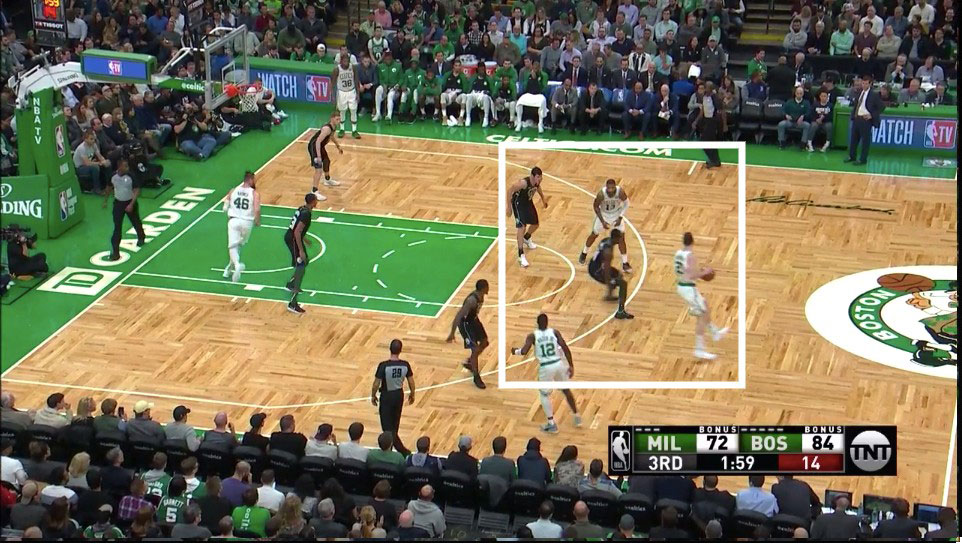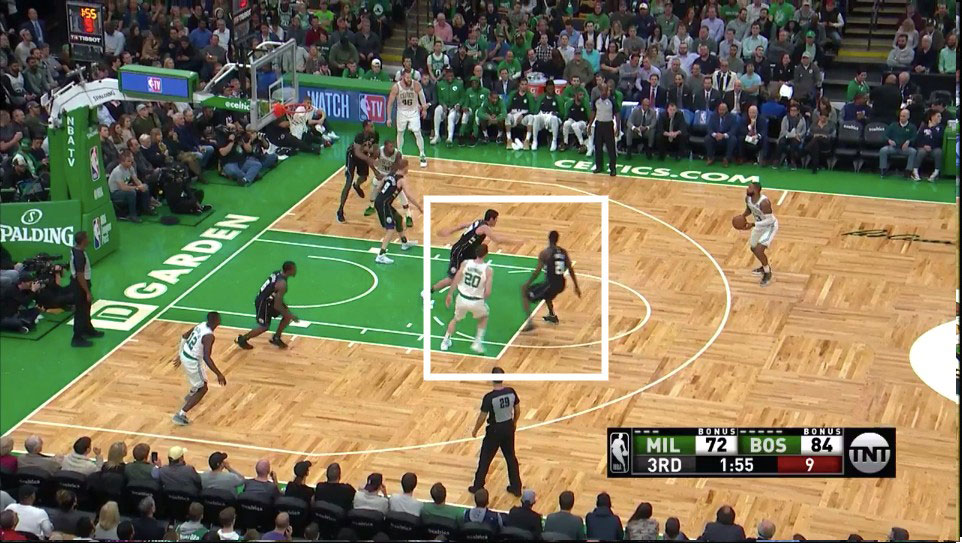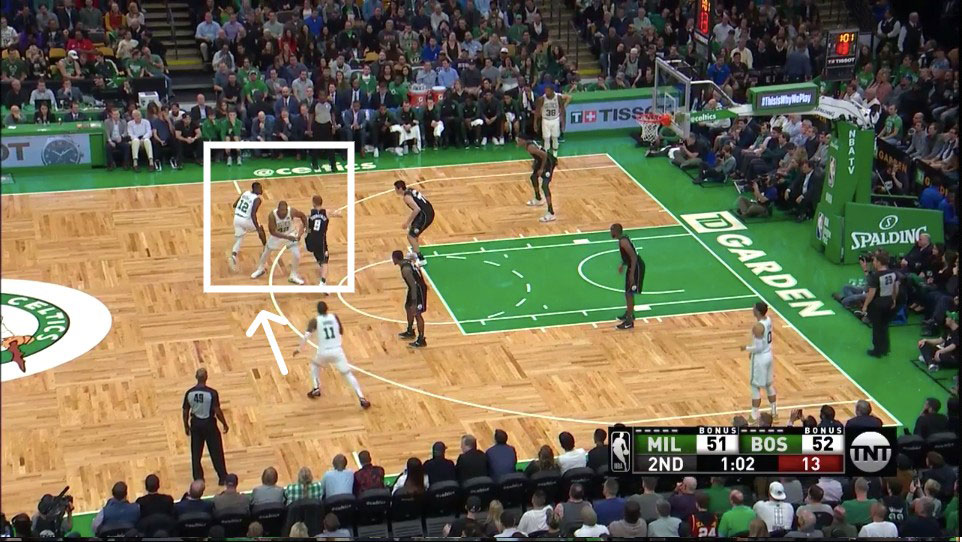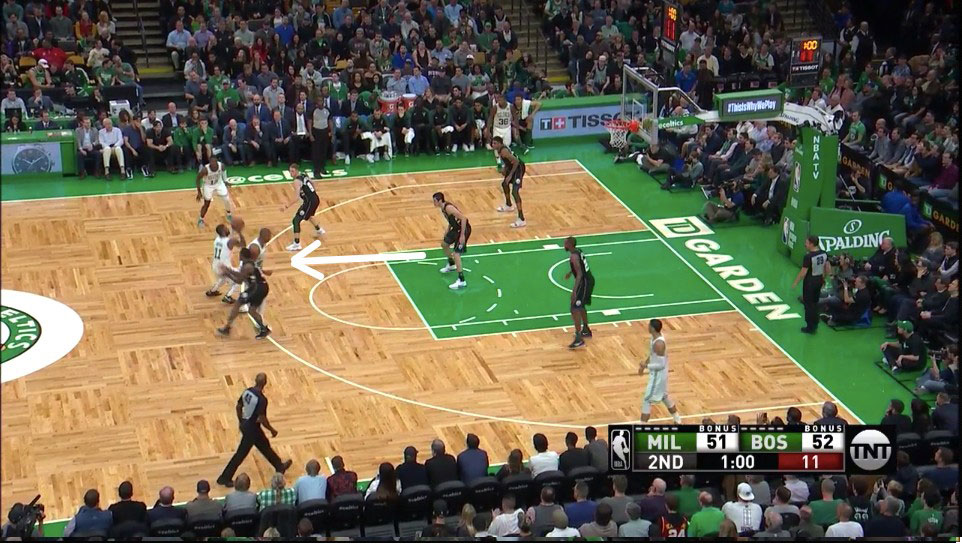5 takeaways from Bucks-Celtics
The Boston Celtics handed the Milwaukee Bucks their first loss of the season Thursday night, burying them with a barrage of 3-pointers and exposing some flaws in the Bucks' revamped defensive scheme.
Here are five takeaways from Boston's 117-113 win.
How the Celtics set a franchise record with 24 threes
The Celtics came into the game with a clear plan to exploit the gaps in Milwaukee's defense. Boston launched 14 threes in the first quarter alone, spamming the pick-and-pop with Al Horford.
The Bucks prioritize protecting the paint above all else, so they drop their bigs back and double-team ball-handlers when they drive. The Celtics knew this, so they stationed Horford up top to capitalize on open looks whenever Kyrie Irving drew the second defender.
Boston repeatedly ran the same action until Milwaukee finally switched up its scheme, but it only really worked when Horford played center. The Celtics tried to replicate this strategy with Aron Baynes, but he's most effective as a 3-point shooter from the corners and was clearly out of his range at the top of the floor, shooting just 1-of-5 from deep.
Stevens gets creative
Celtics head coach Brad Stevens also came prepared with counters that generated open looks for players like Irving and Marcus Morris, who combined to sink 11 triples.
Setting up Morris was relatively simple. The Celtics only used Morris once as the pick-and-pop man in their first four games, according to NBA.com, but they capitalized on the Bucks' defense by having him set ball screens instead of a non-shooter like Baynes.

Milwaukee predictably doubled on the drive, which left Morris with acres of space to shoot. He drilled 5-of-8 from deep to push his 3-point accuracy to a blistering 51.3 percent on the season.

Boston also used the pick-and-pop as a decoy. This worked especially well with two ball-handlers on the floor, as one would initiate the action while the intended shooter would fly in from the weak side around an off-ball screen.
Take this set from late in the first half. Terry Rozier comes off the high screen with Horford and the Bucks drop Ersan Ilyasova into the paint in anticipation of the drive. But instead of standing at the 3-point line, Horford moves to screen for Irving, who cuts up top.

Eric Bledsoe gets caught on Horford's screen and Rozier delivers an easy pass to Irving, who has a wide-open look because Ilyasova had retreated into the paint due to the first action with Rozier.

The Bucks still hold the second-best defensive rating in the league, but the Celtics did expose a weakness in their game. Fortunately for Milwaukee, not many teams in the East have a pick-and-pop big like Horford or a coach as clever as Stevens.
How the Bucks can adjust
The Bucks' drop-back approach to pick-and-roll defense this season has mostly worked like gangbusters, but the Celtics aren't the first team to expose its limits. Apart from pick-and-pop bigs, they're vulnerable to quick guards who can pull up from deep, as Kemba Walker showed on opening night when he torched them with six off-the-bounce threes. If the Bucks' guard is even a split-second slow getting over the screen, they're in trouble.
As good as Milwaukee's defensive rating looks on its own, it's been hugely aided by the fact that opponents have shot just 31.3 percent on wide-open threes, of which they surrender the most in the league, according to NBA.com. The Celtics got 34 of them Thursday night.
The Bucks' best counter, and the way they closed both this game and their game against the Hornets, was to leave Brook Lopez on the bench and run Ilyasova at center while bringing him up to at least the level of the screen to try to show and recover.
That leaves them more vulnerable underneath (and they would've been scrambling here if Rozier could've slipped a pocket pass to Horford), but it's a preferable outcome in situations like this, and it's still a far cry from the high-risk blitzes the Bucks employed under Jason Kidd. Still, at some point, Milwaukee is probably going to have to consider just switching these actions.
Giannis continues to own Baynes
The Celtics generally did a solid job of defending Giannis Antetokounmpo by forcing him to play in isolation. He still scored 33 points on 13-of-22 shooting, but only recorded two assists as the Celtics resisted sending a second defender.
Horford was excellent as usual while Irving was surprisingly pesky with his quick hands to strip Antetokounmpo when he gathered the ball. However, the Celtics' best interior defender in Baynes was utterly powerless against the Greek Freak. Baynes is typically a phenomenal positional defender, but Antetokounmpo's length was too much for him to contain.
Here's their first matchup in the second quarter. Baynes cuts off Antetokounmpo's drive toward the middle, but Antetokounmpo is still strong enough to pivot, step through, and convert at the rim.
Two plays later, Baynes tries to cut off Antetokounmpo yet again, but the Greek forward takes off from outside the paint and stretches all the way to the basket for the layup.
Antetokounmpo has a history of dominating Baynes, and the latest entries were fairly tame in comparison to his work from last season.
Kyrie's back
The Celtics' offense stumbled out of the block this season, in large part because Irving took a while to really look like himself; he lacked his typical explosiveness and struggled to shoot the ball. After breaking out against the Detroit Pistons on Tuesday, Irving continued to round back into form against the Bucks, splashing six 3-pointers en route to 28 points while racking up seven assists and repeatedly diming up Horford in the pick-and-pop.
In addition, Irving's relentless movement without the ball was just as notable as his impressive stats. The Celtics seem to have made a point of using him more as an off-ball threat - he's holding the ball almost a full second less per touch than he did last season, and has slashed his total time of possession by over a minute per game, according to NBA.com - instead redistributing his initiating duties to Horford, Rozier, Gordon Hayward, and Jayson Tatum.
Irving never stopped moving while away from the ball against Milwaukee, setting off-ball picks, making split cuts and darting to the corner, and repeatedly burning the Bucks off flare screens. The result was eight catch-and-shoot 3-point attempts (he'd averaged three per game coming in), five of which he knocked down.
Perhaps most encouraging of all, Irving looked miles better at the defensive end Thursday. He slid his feet well, pressured the ball, and gamely battled bigger guys on switches. He was active and aware in help scenarios, swiping a blind-side steal on Antetokounmpo under the hoop and swooping in from the weak side to block Ilyasova at the rim.
If this version of Irving is here to stay, the Celtics should be able to put their uneven start behind them in a hurry.